The following is a transcript from Grand Prix Omaha 2015. Thanks to the kind folks at Legion Events for not only hosting the artist panel, but for graciously allowing its contents to be posted online. The questions and answers have been edited for brevity.
Seating: Jeff Miracola, Dan Scott, Jim Pavelec, Marco Nelor, Aaron Miller, Winona Nelson, Anthony Palumbo, April King (Moderator).
APRIL KING: We're going to be recording this. I don't know if you guys are familiar with Mike Linnemann at all, but I suspect a lot of these questions will end up on Gathering Magic, and so I'm hoping to transcribe it and get it up there for everybody to see.
AARON MILLER: Oh, so you're not just going to send him the recording?
APRIL KING: That's a good idea. I could just send him the audio file and make him do all the hard work of transcribing it.
AARON MILLER: Hi, Mike! We're talking about you, Mike! [laughter]
APRIL KING: Everybody, welcome to the first artist panel of a GP, at least that I know of. My name is April and I'm going to be moderating the panel. We have seven amazing artists with us here today. As a way of introducing yourself to the audience, I'd like for us to go down the panel and name the cards that people ask you to sign the most. You want to start us off, Jeff?
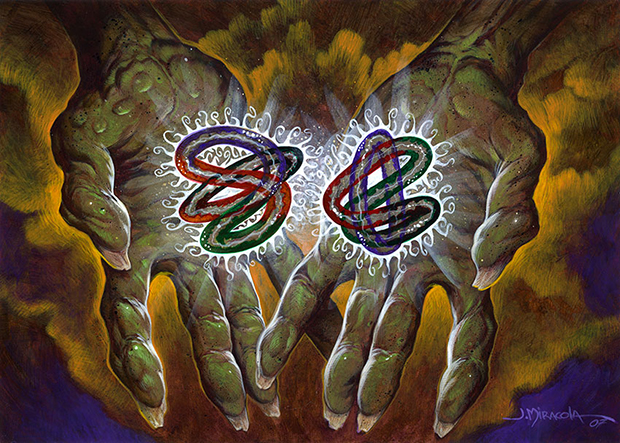
Manamorphose, by Jeff Miracola
JEFF MIRACOLA: No, but I will. [laughter] I'm Jeff Miracola, and I've been doing Magic artwork since 1995. Cards that people have me sign the most of are probably right now Manamorphose and Propaganda. My Beebles are also always popular.
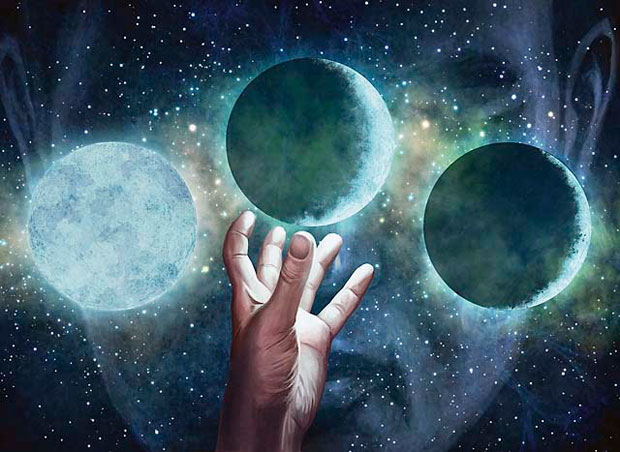
Ponder, by Dan Scott
DAN SCOTT: I'm Dan Scott, and I've been doing art for Magic since 2004. Ponder is probably the most famous card that I've done. Of the recent sets, Jeskai Ascendancy is pretty popular right now; possibly getting banned soon. [laughter] Cross fingers! And I just did Daretti [Scrap Savant], my first planeswalker and one I was pretty excited about.
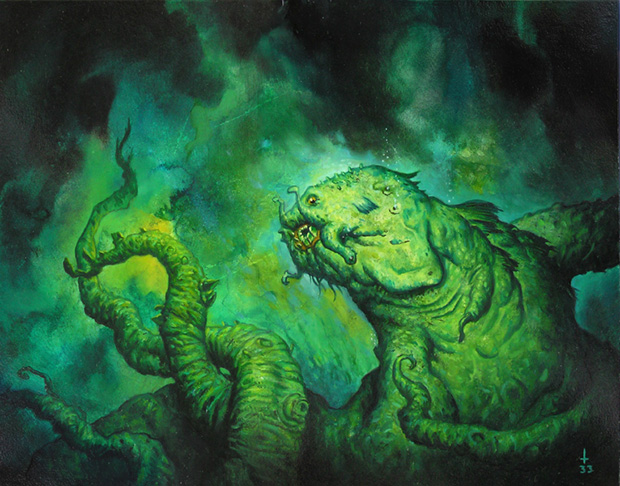
Denizen of the Deep, by Jim Pavelec
JIM PAVELEC: I'm Jim Pavelec, and I've been working on Magic for about eight years. I would say Mirrorweave and Denizen of the Deep are my most popular cards.
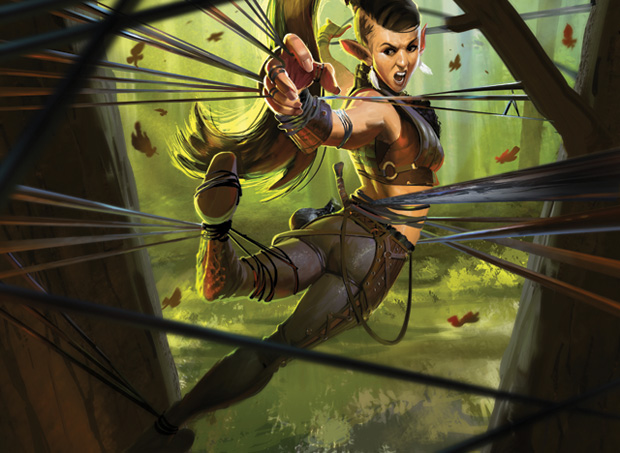
Tangle Wire, by Marco Nelor
MARCO NELOR: I'm Marco Nelor, I'm pretty new. I've been doing this for two years, maybe three, so I don't really know what my most popular card is yet. I did do Tangle Wire, which seems to be pretty popular, just based on how OP the card is. [laughter]
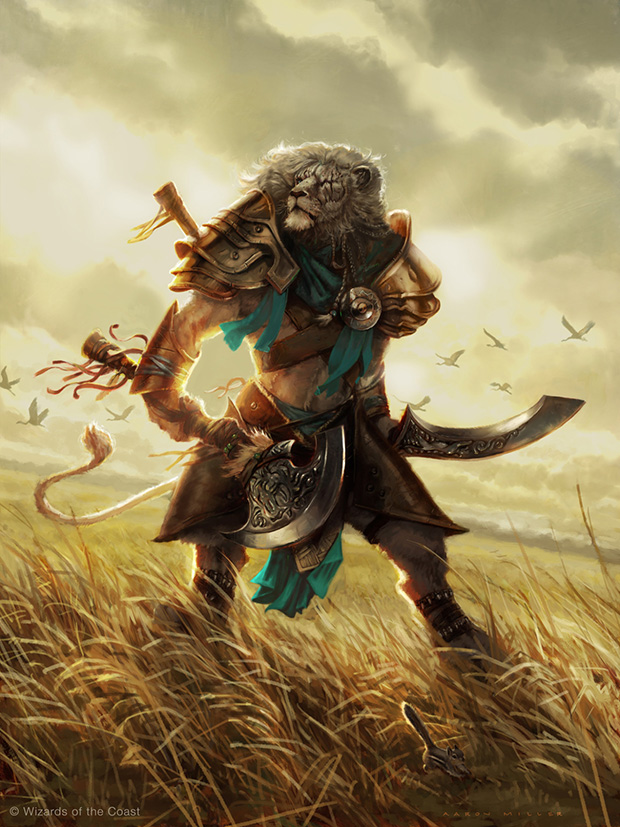
Ajani, Mentor of Heroes, by Aaron Miller
AARON MILLER: I'm Aaron Miller, I'm new as well. I started with Theros. Umm, let's see, my most popular card... I've got the... [laughter]
APRIL KING: How can you choose? They're all so popular! [laughter]
AARON MILLER: Ajani! [laughter] It's so Ajani!
JIM PAVELEC: It's so Ajani!
AARON MILLER: And probably Chained to the Rocks. Bloodsoaked Champion also seems to be a big deal right now.
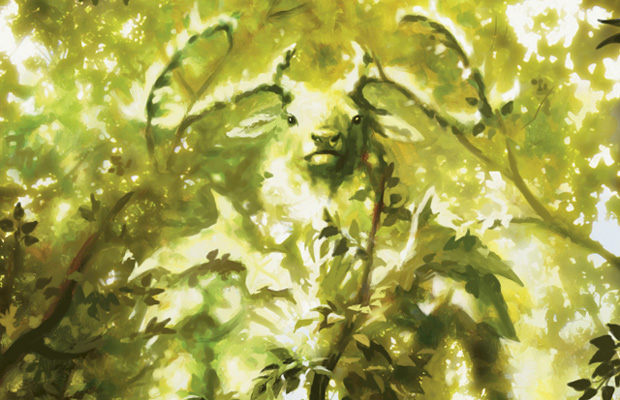
Voice of Resurgence, by Winona Nelson
WINONA NELSON: I'm Winona Nelson, and I started with the Innistrad block about five years ago. My most popular card by far is Voice of Resurgence.
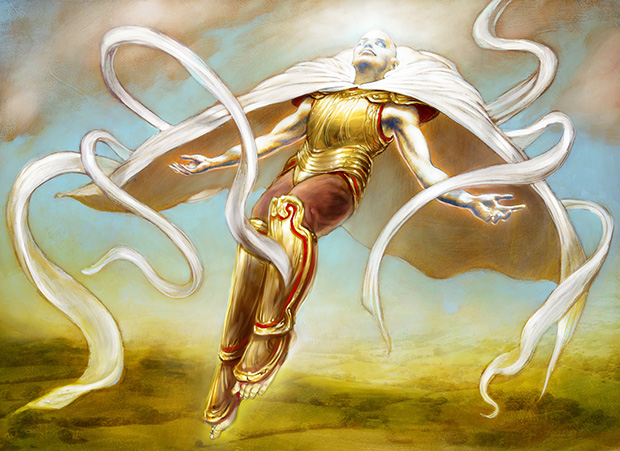
Serra Ascendant, by Anthony Palumbo
ANTHONY PALUMBO: I'm Anthony Palumbo, and I started about five years ago. My most popular card is probably Serra Ascendant.
APRIL KING: So, we're here at a GP and the lines are around the block to have you guys do card alters. It's your bread and butter, and so I'm curious as to what is the strangest card alter request that you've gotten?
DAN SCOTT: Name a body part? [laughter]
WINONA NELSON: I had one that was super confusing, that would have been funny if I had understood the guy. This was in Japan, and he didn't speak any English; he just said one word. He handed me a Voice of Resurgence and he said, “Salad.” [laughter] And I didn't do a salad because I was sure that it wasn't the word he meant to say. But afterwards I was like, that would have been really funny. [laughter] So that's the strangest one I didn't do.
APRIL KING: As a Magic player myself, I would say that most players identify with a particular color. “I'm a blue mage” or “I'm a red mage!” When you receive your art descriptions, is there a color that you're always hoping comes in? Are you thrilled that you get to paint a white card, or does it not matter?
AARON MILLER: It's really, “I just get to paint a card!” [laughter] “They called me again, thank god!”
MARCO NELOR: I don't know if I'm having bad luck or good luck but I seem to get handed green cards by default. They're usually Elementals, so I guess that's where my niche kind of is? But yeah, I'm the green guy.
AARON MILLER: I've done a lot of white, black.
DAN SCOTT: I like doing black. As a player I enjoy blue, but as an artist I enjoy black, because all the rules just kind of go out the window. You can just go and make something as crazy demented as you want.
JIM PAVELEC: Yeah, black is my favorite as well.
AK (to DS): You said you played Magic. Do the rest of you play Magic at all?
MARCO NELOR: I dabble every now and then.
AARON MILLER: Yeah, I've played.
JEFF MIRACOLA: I just started to learn, after all this time... [laughter]
APRIL KING: Do you ever sit down to build a deck and think, “I'm going to build a Jeff Miracola deck! It's only cards that I did!”
JEFF MIRACOLA: Well, I don't know, I haven't gotten to the point of trying to build a deck yet. We learned at GP Portland. [Six months ago. - Ed] The judges taught Aaron and I how to play and since then I've played a couple games with my son. At the GP they gave us a box of cards -- they gave us all this stuff. I get home and I give it to my son and he disappears with it across the street with it with his friend. He comes back about an hour later and he's like, “Okay! We know how to play!” [laughter] I'm just like, “It's been twenty years for me!” So yeah, he's already really good at it.
DAN SCOTT: Speaking of building a deck with cards, I heard Chris Moeller did that?
WINONA NELSON: Yeah, he's got one with all of his. He had to ask the art director to give him land cards, so he could finish out his deck. [laughter]
JEFF MIRACOLA: I've heard Kev Walker is close to creating a cube?
APRIL KING: Yeah, he's, like, twenty cards off from getting that completed? [Kev is currently only nine spells and two basic lands from completing the cube. - Ed]
DAN SCOTT: Yeah, I'm the one that started as a player, so I know the game pretty well. I'd like to do that sometime, build a deck from my cards. I've done, like, 150 cards now?
APRIL KING: There's gotta be a decent deck in there somewhere; it probably contains Jeskai Ascendancy and Ponder. [laughter]
DAN SCOTT: Yeah, it's gotta be based on those colors for sure.
APRIL KING: Okay, have any of you ever had an art description that you really struggled with or you really didn't want to do? I'm looking specifically at Jim Pavelec and his Pulling Teeth, which just makes my stomach churn. So when you get a description like that, what do you think?
JIM PAVELEC: Well, that's my favorite stuff to do. So I was all excited when I got that. And the sketch I sent in for it was actually too gross.
APRIL KING: It was too gross?!
JIM PAVELEC: Jeremy [Jeremy Jarvis, art director at Wizards of the Coast - Ed] was like, “Woah! That's a little too much! You've gotta dial that back!” So, yeah. Then they almost didn't print it because it was still a little too gross, but it just made it under the wire. So I like that stuff; it's not a problem for me. But if I got something that was all bunny rabbits and cutesy stuff, I'd be like, “Oh boy, that's no good.”
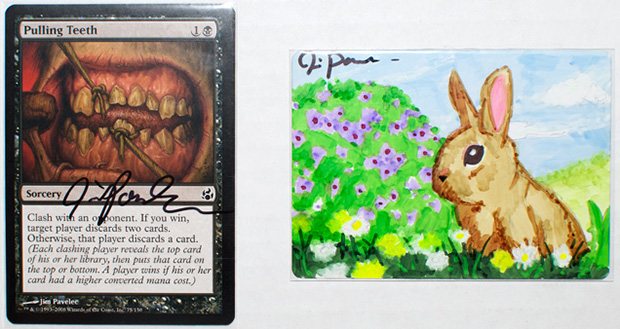
Great artist proof sketch, or THE GREATEST artist proof sketch?
MARCO NELOR: I'm a new guy, and not especially one who is an illustrator. I just did pure concept art before Magic, so some of the descriptions that we get, from a guy who has never done illustration, are... I just don't even understand how to do that. I think the most interesting and complicated one that I ever did was Tangle Wire, 'cause there's a lot going on there. It was my first one, and it was like: I want you to draw a picture of a guy made out of wires, but his face is another guy's face, and then the guy who's below him needs to have his face, except it's not really his face anymore. [laughter] And I'm just like, wait? I'm tangled up! So the first attempt that I did, I took a stab at it and it actually got shot down; I had to completely redo the card. And that was the third card that I had ever done, from never doing cards before. It was pretty complicated.
ANTHONY PALUMBO: I'm scared of doing any that have fire in them, because I think that fire is something that I struggle with painting and I've now done around five cards that are like a man made out of fire. [laughter] I always feel like I blow it so hard on those, but anyway...
MARCO NELOR: They always seem to find exactly what you aren't strong with and then give that to you, because I asked Jeremy the same thing. I'm like, “Why do you keep giving me plants? I suck at plants!” [laughter] He's like, “Nah, you're doing fine.” Meanwhile I'm just staying up until like 3 in the morning. Plants, I'm tired of plants... [laughter]
WINONA NELSON: I don't know what's up with you guys, I don't have any problems! [laughter] They just keep asking me for beautiful characters, and I'm like, that's all I want to do, so... and giant cats, those are fun.
AARON MILLER: I still think they're feeling me out. I've got cards coming out that are not anything I've done before. One just got spoiled yesterday; it's my first weapon. So that felt a little odd. But, everyone is like, whatever, it's a challenge, let me see where I can take this.
APRIL KING: So is it just a weapon, or is like a weapon on a...?
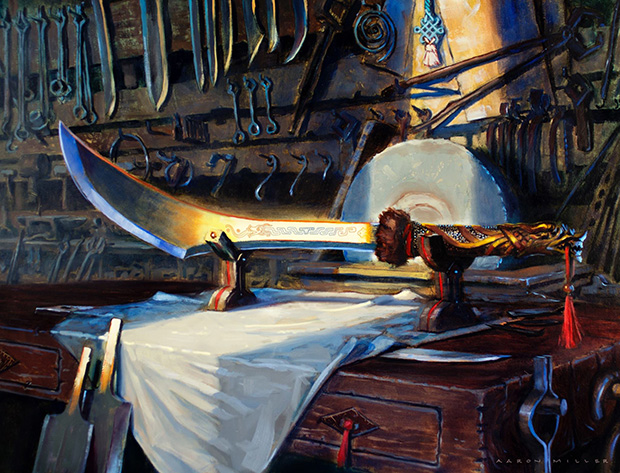
Hero's Blade, by Aaron Miller
AARON MILLER: It's an artifact, so it's just sitting there. That's what they wanted, sitting in a rack or something like that, so I can make it cool.
APRIL KING: It does seem difficult to illustrate an artifact that's static and unmoving, as opposed to the more dynamic pieces that are typical of Magic art.
MARCO NELOR: The opposite is also bad. I got Whip of Erebos's art description, and it was like, “We want a whip. It needs to be the size of a mountain.” [laughter] “The actual whip part needs to extend forever into eternity.” And I've never known how hard a straight line was to draw, because it's like it needs to be a straight line that's this width in the foreground and receding perfectly all the way to this width and snaking like a snake. And then the killer part was that in that whip, you have to also have to have the galaxy. [laughter] So I was like, “How do you put a galaxy in a whip?” But it turned out pretty good, I think.
WINONA NELSON: Maybe they just have more confidence in you guys? [laughter] “Can you draw a shirtless dude?” And I'm like, “Okay!!” [laughter]
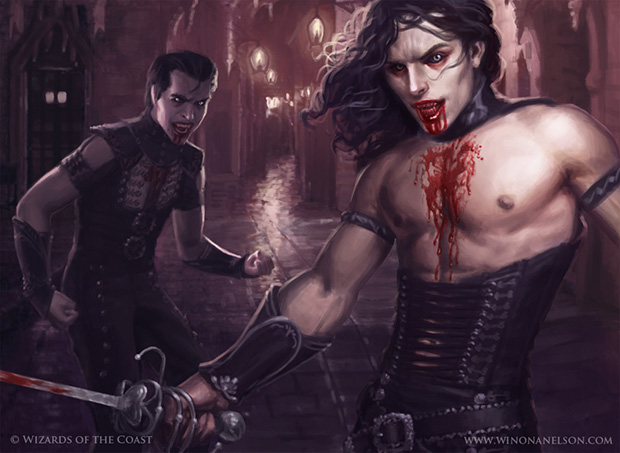
Rakish Heir, by Winona Nelson. Okay!!
DAN SCOTT: I think getting the ones that aren't characters can be a little bit more difficult, like an artifact or something like that. I did one called Increasing Confusion, which was just a bunch of books and beakers and stuff that were flying off the shelf and bursting. That was a nightmare to do, just drawing books and pages flying all over.
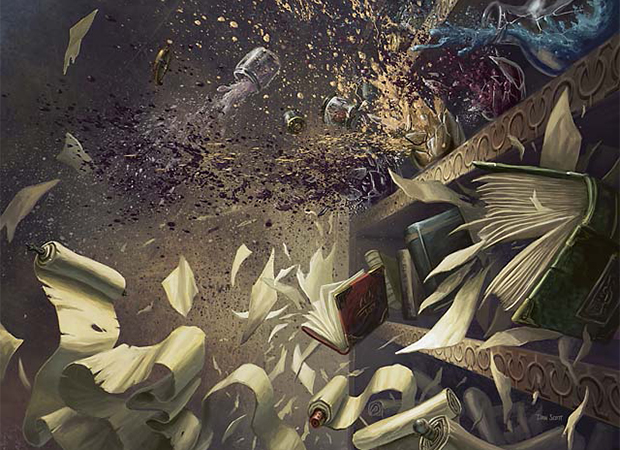
Increasing Confusion, by Dan Scott
APRIL KING: That does sound confusing!
DAN SCOTT: Yeah!
APRIL KING: Many of you -- I think all of you except Aaron here -- have done a remake of somebody else's art. Jeff, I think you did Manabarbs. And we've got two of you who did Blightning. Winona did Elvish Mystic, Anthony did Pithing Needle. [Jim Pavelec and Dan Scott did Blightning - Ed]
JEFF MIRACOLA: Right, Manabarbs.
WINONA NELSON: A couple of us have done each others; I did a promo of Tony's. [Resolute Archangel - Ed]
JIM PAVELEC: Didn't someone do Repeal, though? Was that Anthony?
WINONA NELSON: That was Dave, Dave Palumbo. [Winona was thinking of Cancel; Anthony Palumbo actually did illustrate Repeal. - Ed]
APRIL KING: Anyways, many of you have done remakes of somebody else's art. When you receive an art description of a piece that has been done by somebody else, is it daunting or does it change your creative process? Are you tempted to go and take a look at the other artist's illustration?
JEFF MIRACOLA: They took advantage of the fact that I didn't know how to play the game or that I didn't know the game, by not telling me that there was previous art. So I didn't get to see some of the previous art for some of the stuff that I had done.
WINONA NELSON: They don't usually tell you when there is previous art. I didn't know for Elvish Mystic, but I knew for Resolute Archangel because Tony did it. That was a special kind of stress because I was like, “I've gotta make it better than his, but not better than his.” [laughter] [Context: Winona Nelson and Anthony Palumbo are a couple. - Ed]
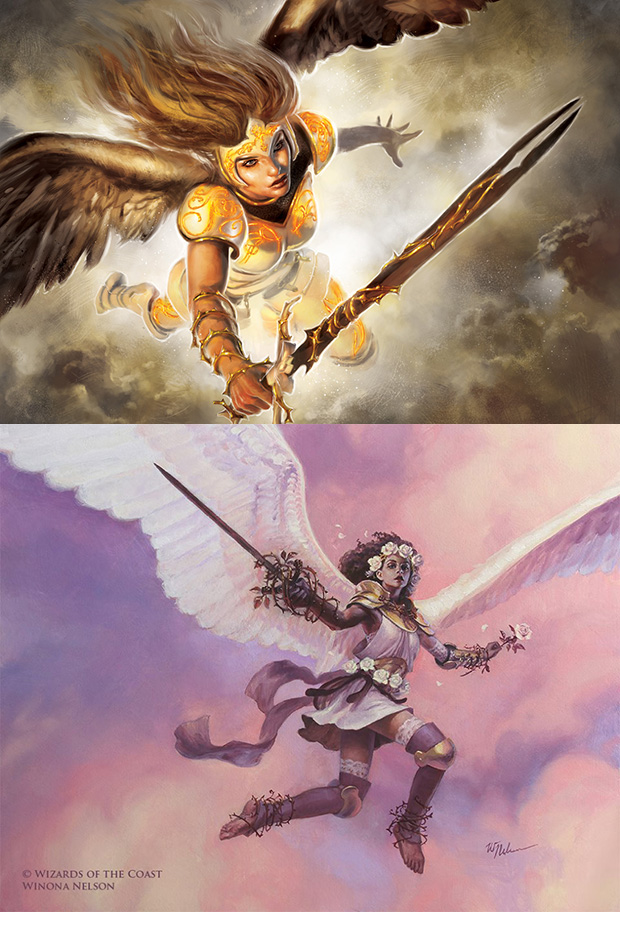
Resolute Archangel, by Anthony Palumbo and Winona Nelson
DAN SCOTT: Sometimes I think they commission them at the same time. I think maybe Fathom Mage was commissioned from two different artists as they were releasing the promo version and the regular version at the same time.
MARCO NELOR: I recently did a promo for one of my own cards, and I think they told me that I was one of the only artists they've ever let do a promo of their own art. I don't think it was a special privilege, but I think they just love giving me those greens. [laughter] It was literally, I did this guy and two days later, they were like, “Okay, we also want you to do the promo of that.” and I was just, stop giving me greens, please. For the most part though, they don't tell you and it's kind of sneaky. When I did Tangle Wire I got the description and I was like, “Okay, that's kind of weird, fine”, and I did it. Then later somebody was like, “You did Tangle Wire?!” And I was like, what's Tangle Wire? Whaaat..? And I think before that Crosis's Charm and Dromar's Charm, which they did give me art for those in the art description email. For some reason, I just could not get past how hard that was to do. Jeremy's like, “Redo it.” And I was like, “It's right there!” [laughter] [Similar to Steve Belledin's experience with Nightveil Specter - Ed]
JEFF MIRACOLA: It's better if they don't show you!
MARCO NELOR: It's very much better.
AARON MILLER: I'll have a promo next year.
APRIL KING: You will have a promo next year? Next time we have this panel, I will definitely ask you what it was like.
AARON MILLER: Perfect. Well, I had no idea they'd send me the art.
DAN SCOTT: Personally, I love doing the reprints though, because if they give you a reprint, it's gonna be a playable card. They reprinted Ponder and when I did that I knew that I was doing art for a card that was going to be played and it was going to be a staple in a lot of decks. I was excited, because, if a card is playable then more people will see your art and it's going to get more attention. You can do the most beautiful piece of art, but if it's on a card that's unplayable, no one is going to see it.
WINONA NELSON: See, a reprint and a promo are different in that respect, because promos you don't always know how strong they are in the game, but a reprint is always a popular card.
APRIL KING: Speaking of that, I assume all of you have probably done one art where you were thinking, “I really crushed this art, this is incredible!” only to find it ending up on a common card that nobody ever plays. Does that ever bother you, to find your pieces of art getting ignored by Magic players?
MARCO NELOR: No, but the inverse does. [laughter] You have a card which you don't know is gonna be awesome, but then you're slammed with other deadlines and you do it but you don't really know. You're like, “Eh, that's just a rat,” and then later you find out it's like the biggest rat in the world. [laughter] That happened on one that was also a reprint, and people were like, “I hate this!” It's hard like seeing the two versions right next to each other, especially when you Google search them. You think it's yours, and you're like, “Ah, that's my card! Oh, wait, that one's way better!” [laughter] Whoops!
JIM PAVELEC: Yeah, I did a piece that I didn't know was going to be a giant size promo card and it's probably the worst painting I've ever done. And then they gave it to Ultra-Pro and it was on packaging and it was everywhere, and I was like, “Oh, if I have to see that painting again I'm going to shoot myself.” [laughter] Yeah, that is the worst.
MARCO NELOR: I guess the cool thing about that though is that, I guess sometimes the paintings that you feel are your worst paintings actually kind of, in a certain light, are your best ones... [trails off] [laughter] I've seen a few that some people hated, and I was like, “That card was just awesome. That is just a super awesome card.” I think a lot of the times we hate them because they don't feel like something we would normally do. I have a thing that, if I paint on my own time, I'm always going to paint this one thing. Then I paint this other thing and I hate it, and it's actually way better because it's sort of outside my comfort zone which is where the Magic happens. I dunno man, I think it's probably a pretty kickass card... wait til you see it... [laughter]
APRIL KING: Jeff, you've been around for a very long time. I mean, I'm not saying you're old, or anything... [many murmured comments in the affirmative] Many years ago when Magic was new, art descriptions were incredible vauge. Sometimes they just had the name of the card...
JEFF MIRACOLA: Which was always changed.
APRIL KING: It was madness in early Magic. You've been around and seen the changes in art description as the years have gone on. Do you prefer the classic open-ended Magic experience, or do you prefer the newer art descriptions where you have style guides and detailed descriptions?
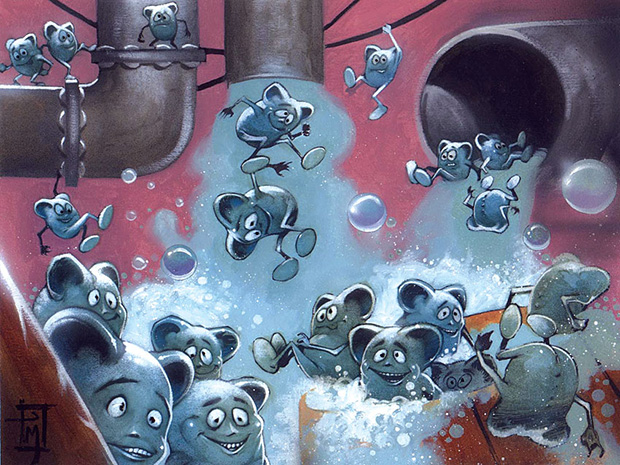
Bubbling Beebles, by Jeff Miracola. It was madness in early Magic.
JEFF MIRACOLA: I liked them both for different reasons. I like the open-ended stuff from the beginning because you could just do whatever you wanted and have a lot of fun, so the artist in me says yes to that. But, the businessperson in me says that the current stuff is better because it keeps people on point. There's a look and feel to the game now that's consistent. Now, some people might not like that about it; I get lots of people who come up to me and say, “Oh, I wish the game had more like the old stuff in it, the varied styles and stuff like that.” But, you know, you've got to establish a brand look. That's important in this day and age. So I prefer them both. I think if you give artists too much freedom then everything is going to go off the rails. Keeping people on point with the style guide is important. It is interesting to see it change over the years from when all they gave you was just a color, and a name, and said, “Do whatever the heck you want,” and then to see how intense those style guides get now.
MARCO NELOR: I feel like one of the recent things that has sort of changed is letting you have a bit of open-endedness, by giving you freedom with the word “could.” Now in the descriptions they'll give you a really long description and then they'll say, “This is what it could be. You could draw this.” Then it's kind of easy to do that and if you don't hit that you can kind of deviate and go this other way.
DAN SCOTT: They do a really great job of giving you a description that inspires you instead of confining you. It doesn't tell you, like, “Draw this guy with a staff in his right hand and on this side...”, and it doesn't get into actual perspective and the details of what the painting is going to look like. It's just kind of a vague idea of what the feel of it is. They've got a style guide to kind of give you some guidance, but they're not real strict about dictating what it needs to look like exactly. I feel like they've got a good middle ground on that.
APRIL KING: Jeff mentioned Magic having a particular branded look. What do you feel separates Magic art from generic fantasy art?
AARON MILLER: So I think one of the things we do is we don't hit those generic fantasy things the same way. We try and take them with a little bit of a twist or some of those elements, like the knight on the horse with the castle, are just not present. It's just not going to be Magic art. Magic worlds are just going to be a little more severe, a little darker; you don't really know who is the good guy and who is the bad guy.
WINONA NELSON: In the style guides, they have an overall “this is what the Magic brand needs to have” introduction part. And it says specifically this isn't a land of wizards and pointy hats, this is mage punk. So yeah, they give you kind of a specific introduction to keep in mind that, you know, 15-year-olds have to think it's cool.
APRIL KING: As the years have gone on, Magic art has become this colossus that looms over the fantasy art world, with annual awards like Spectrum where Magic continues to swallow a larger and larger piece of the award pie. What do you think is the future of Magic art? Where can we go from here?
ANTHONY PALUMBO: I think that has a lot to do with what other companies do. The thing to me that has made Magic stand out is that nobody else rewards the artist for that quality in the same way. Having the best art is just not the priority to other card games and stuff like that. If somebody else comes along and does that, it would push Magic.
DAN SCOTT: I think most other properties, they're more concerned with their brand. If you're doing something for World of Warcraft, it has to look like World of Warcraft. If you're doing something for Warhammer 40K, it has to look like Warhammer 40K, it has to look the Warhammer 40K universe. They have a very specific look and with Magic, they're more about the artists. They hire good artists and then they let them do their thing. I think that's why a lot of the art wins awards, because the artists have freedom to do something really cool without having someone overdirect them.
WINONA NELSON: Magic also, they way that they reward the artists financially is better than any other of the card game companies and most other art companies at all, because you retain the rights to sell prints and do original artworks with those characters. And things like that, having done work for Warhammer, even submitting Warhammer work to Spectrum is technically not allowed because they don't want Warhammer work to appear in some place that doesn't say Games Workshop on it. So, I've broken that rule a lot of times, but that's because they're in the UK and I kind of think they won't find out. But, I've never had them turn around and say that I shouldn't have done that. I've actually had the art director there tell me to just, that he was going to pretend that I hadn't asked him and just do it. So, yeah, and I mean if you can't even submit a Warhammer piece to Spectrum, you're not going to win a Spectrum award with it, and you might not really put as much energy into something that you know you're not going to have any kind of ownership over. I think there's definitely, like, when you're doing Magic you feel more like this is a company that is giving back to you also.
APRIL KING: Speaking of the ownership of Magic art, those of us who follow the secondary Magic art market where original paintings are sold have seen prices go truly insane over the last year, with multiple pieces going for over ten thousand dollars, including one by the esteemed Aaron Miller right in front of us.
AARON MILLER: Oh, no, no, that wasn't me. [It was Chris Rahn's Ajani Steadfast, which went for $14.545. - Ed]
APRIL KING: Oh, that was not you.
AARON MILLER: No, the highest was six.
APRIL KING: Oh, I apologize.
AARON MILLER: That's okay. Give me a month, I might change that.
APRIL KING: As prices have gone up, has that caused any of you to reconsider the way that you do Magic art or your choice of media?
MARCO NELOR: Well, shit. [laughter] I mean, I didn't know that. So, uh, everything changes now. I think it's interesting, me being here on my first panel. For those of you who don't know, I come from video games. I do games and they don't want their artists to do anything.
WINONA NELSON: Anything outside of the game?
MARCO NELOR: Yeah, anything outside of that. They don't want you to put your name on anything, they don't want people to know you did stuff, and any piece of artwork you did is not going to come out for, like, five years when the game comes out. Even then, they show, like, one or two...
WINONA NELSON: They're going to say, “This is from Blizzard”, and not from the artist name.
MARCO NELOR: Even with that, for example, I work on Injustice: Gods Among Us, which is a fighting game. When creating characters, I did, like, twenty versions of this character named Cyborg from the DC Universe, and I wanted to show all of them, because that was three or four months of work that I did. I went to show them three years after the game was out and they were like, you can't show any of those because all of them are different from the one that is in the game. And I'm like, well, I'm a concept artist, they're all going to be different. And they were like no, you can't show them, you can't put them on your website, you can't do anything like that. Hearing these stories about how we're allowed to have more ownership in what we do, I'm inspired sitting right here. I want to do some more Magic art. I might walk out of my job tomorrow. [laughter] I'm not even joking, I'm about to pick the phone up right now and call my boss and walk out of there...
DAN SCOTT: As a 100% digital artist, yeah, it definitely makes me consider. I started off as a traditional artist, and it makes me want to pick up the paints again and produce some original art. Personally, I really enjoy the look and feel of oil paints and having something tangible that you can hold in front of you. Holding it up and saying, “I did this!” instead of as with something digital is really cool, but the extra income from the resale value is not a bad benefit either.
APRIL KING: Do you lie awake at night, and think, “Ponder. I wonder how much Ponder would get on eBay?”
AARON MILLER: Well, I do both digital and traditional and the struggle is making sure that the art directors are happy because there can be a difference and if I'm not making them happy with my paintings then it just makes it harder to keep making traditional paintings no matter how much I want to paint. Right now, the idea is to paint and then have that as my first digital layer if I have to. And if I don't, then good. I just finished one where I struggled and struggled and I did this painting and I felt good about it. And then something wasn't right, and now it just doesn't look like the one that is going to be printed, except that you can see the bones of it. But, I had to fix it and I'm happier with the final illustration...
WINONA NELSON: The digital version?
AARON MILLER: Yeah. But I'm stretching and moving painted pieces and so it's still going tobe this really cool illustration, it's just that the actual painting isn't going to look like the card now. And I couldn't just make a few changes, it's a lot of changes. But it was worth it. It's just gonna take time until the drawing and the concept are all nailed down before I ever pick up the brush, so that the paintings are just going to stay the same. You know, that's just my struggle as I'm learning to paint better.
JEFF MIRACOLA: I never made that jump from traditional to digital. For all my fans here, I stuck with traditional since I've started. I do digital for my children's book clients, but for any of my fantasy art it's painted because I like the smell of oil paints...
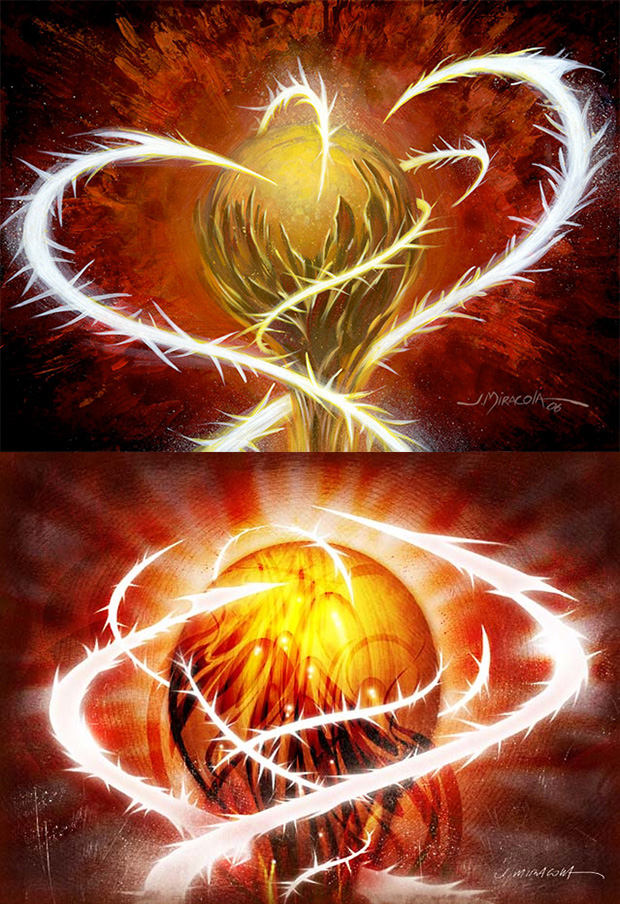
Manabarbs, by Jeff Miracola. Traditional vs. digital: the struggle is real.
APRIL KING: I thought Manabarbs was digital, is that not the case?
JEFF MIRACOLA: No, I submitted a digital sketch for that, and the sketch was so detailed for that, that I asked Jeremy, “How about you just use that,” because it was so fast to do. I think I got the sketch done in, like, two hours. And he was like, “No no no, I want a painting from you.” [laughter] So that took me like four or five days. So yeah, everything's been traditional and I enjoy too much; I enjoy working that way. I love the digital stuff that these guys do, it's just so amazing, but there's just something about paint, I can't get away from it.
APRIL KING: So I own a number of original paintings and one of the things I always like to do is take the card and hold it up next to the painting. What often strikes me is how different they appear, such as how much they shift the colors, or how the contrast is high on the card where it wasn't on the painting. Do you think Wizards is true to your original vision of how you painted the card?
ANTHONY PALUMBO: I think they are for me. I send everything in as a digital file, even if my painting is an oil painting, I take the photo of it and send them that, so they don't ever tweak it into something different from what I sent. Maybe if somebody sends them original art, they have their photographer do it and it comes out different? But I don't think that they change things...
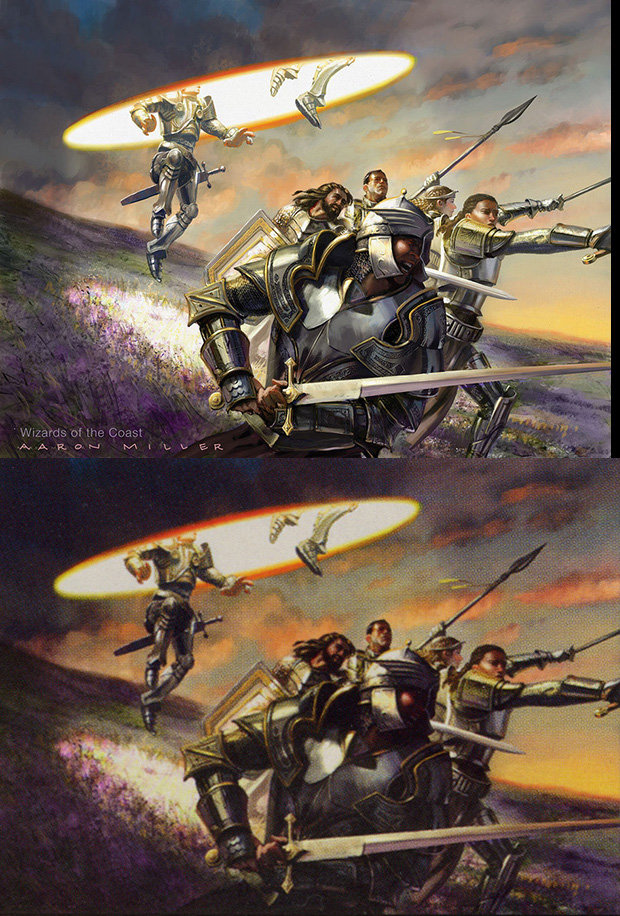
Deploy to the Front, by Aaron Miller. Wizards loves contrast!
AARON MILLER: A little bit. Deploy to the Front, they printed a lot darker than the art that I created. It might have felt a little washed out, but I think they went a little overboard and it feels really dark now.
WINONA NELSON: I think almost all of them print a little bit dark. So I kind of try to work around that. But generally I don't even look at the printed card, because I don't expect it to look the same as the painting.
MARCO NELOR: I think Tangle Wire for me was only printed in foil, and that came out super super dark. There has been a big difference recently though. I don't know if you guys got it, but there was an email sent out about three or four months ago about how they're changing the way they're doing color. So I think they may have noticed and changed that, but mine definitely always print way darker than I illustrate.
JIM PAVELEC: I've had quite a few come out much darker than the actual painting, and it bothers you a little, because I spent time getting certain colors into the shadows and those all just go to black and it really flattens things out. But for the most part, it's close enough.
DAN SCOTT: And digital art is going to be hard, because the digital RGB color space's gamut is wider than the printed piece. Purples and cyans and stuff like that that might look really vibrant on screen, but when they get printed they look completely different. They can dull out a lot.
APRIL KING: So, I'm curious, have any of you ever spent a bunch of time working on a piece, sent it in to whoever the art director is at the time -- I think it's Jeremy Jarvis currently -- and had them say... no. This just isn't going to work. Do any of you have any interesting rejection stories?
AARON MILLER: I had to redo my Ajani piece, because they didn't like the description that I got. So, I had to redo it. That was stressful.
APRIL KING: They didn't like the description they sent you?
AARON MILLER: Right. I started doing all these drawings and sending them in and Jeremy's like, “This is just not good. This is not working. So let me rework this description.” It just got simple after that. It was along the lines of, “Make him look awesome on a field or something.” [laughter] Just make him look tough and we'll go from there and that made things easy, because the other one was just too complicated.
MARCO NELOR: I... am the opposite. He never likes anything I do. [laughter]
DAN SCOTT: Really? I just send it in. Approved, go.
MARCO NELOR: No, it's like... it's weird, hearing you guys say that you talk to him. It's just like... “Marco.” [laughter] But one time, though, there was one time when I actually got actual words out of Jeremy, and it was when I turned in Frilled Oculus. He loved that one! He sent me this long email, he just exploded, and I was like, “Woah! This is what it's like!”
APRIL KING: This is what it's like to be loved... [laughter]
MARCO NELOR: It's also a lot of stress, because that was one of my earlier cards and I've never done anything that good since then, I guess.
AARON MILLER: Been there. “That was so long ago, why do I have to keep being compared to that one card?”
MARCO NELOR: Well, that's kind of cool, though. I guess in the world of Magic, you're known by your best work instead of by your worst.
AARON MILLER: Well, in house, it's different.
MARCO NELOR: In house. [laughter]
AARON MILLER: In house at Wizards is different than with you guys. You guys love everything that may not be loved other places.
JEFF MIRACOLA: I've had three cards over the years rejected, for the art. There have been others you turn in and they get rejected that has nothing to do with your art, such as when the card gets killed or whatever. It goes what they call The Morgue where they just hold it...
APRIL KING: Kind of a grim name for it.
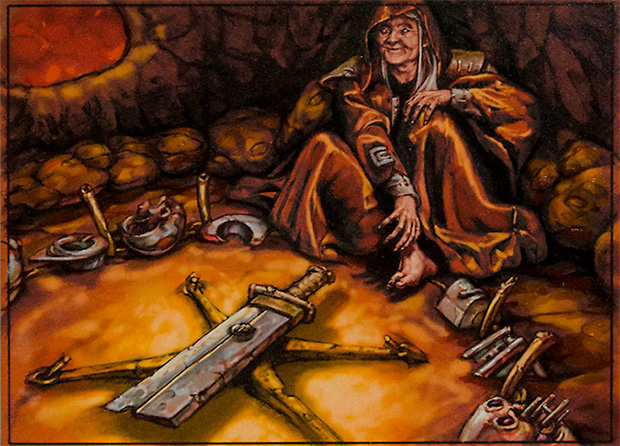
Wheel of Fortune, by John Matson. Sent to the morgue in Time Spiral and resurrected four years later as a judge foil.
JEFF MIRACOLA: Once there, it might appear again someday. I've had three cards rejected because the art was crap and I was so glad they got rejected, because it's one of those things you just don't want out there. Same situation where you're rushed, you've got to do an oil painting in a day, it gets rejected, and it's a sigh of relief.
MARCO NELOR: Wait, how many cards have you had, though?
JEFF MIRACOLA: Over 110.
MARCO NELOR: A hundred and something, and you've only gotten three rejected?
APRIL KING: He's just that good!
MARCO NELOR: I mean, that doesn't add up.
JEFF MIRACOLA: Realize that most of my work was in the earlier days. If I had to be working today on Magic, no way. I'd get everything rejected. [laughter] It was easier to get crap through back then. [laughter]
MARCO NELOR: I think compared to your record, I've done six cards and had five rejected? [laughter] I think I've had one that was rejected, and it was not good. I think they just completely killed the card out of Magic. [laughter] It was so bad. We're not even going to... this card just doesn't even exist anymore.
DAN SCOTT: When you guys say rejected, do you mean it was reassigned to another artist, or they make you start over from scratch?
MARCO NELOR: Like Winona was saying, they're really good with their artists and with the way they compensate you. I had one that was sort of like what Aaron had. The description that they gave me, I worked and worked and worked on that, and later Jeremy was like, you know what, I'm changing the description. But Wizards still compensated me for the other work I had done.
WINONA NELSON: Yeah, when they make you change stuff, they pay you again.
MARCO NELOR: Yeah, that's pretty good. I did have one that was this glowing guy pushing a rock up a hill or something and they just... I worked on it, and then I was late on it because I worked on it so hard and I wasn't getting it. And he was like, you know, we're just going to have to kill it. And then they just totally completely killed it, and I never heard about that card again. That's the card that shall not be named. [laughter] Just don't even speak about it.
DAN SCOTT: I've had more issues with Magic brand than the Magic art directors. I feel that the art directors are really good about not saying something unless it's something really obvious that they can help you with. If Jeremy or Dawn Murin [Senior Art Director at Wizards of the Coast - Ed] say something, it's usually true. But Magic brand, they'll come back to you for something that's too gory, or showing too much side boob or whatever. [laughter] I get a lot more issues with that.
APRIL KING: Wait, there's such a thing as too much side boob? [laughter]
MARCO NELOR: They're pretty strict on that. Originally for Tangle Wire, she had on just a low-cut thing and I guess from the position she was in it was like, “No! No side... butt.” [laughter] I guess that's a thing. They're pretty complicated, they're pretty strict on that, which is good. Which is really good, because like there are other card companies that are out now, which I shall not name...
AARON MILLER: Oh yeah, it's ridiculous.
MARCO NELOR: Those guys over in Japan, oh man.
AARON MILLER: Make her boobs bigger. No, bigger. No no no, BIGGER. [laughter]
JEFF MIRACOLA: Well, Wizards would like to include more women in this process and get more women involved in the game, and that's not the way to do it. I think that's smart.
APRIL KING: I know that, as a female Magic player myself, one of the things I appreciate the most about Magic is that they're really tactful about how they present women on Magic card art.
APRIL KING: Alright, so one last question before we'll open it up for the audience. Do any of you have a Magic artist hero? Is there an artist where you think like, “Oh man, someday if I could only paint like... Noah Bradley?“
Everyone: [laughter and more laughter] “Noah Bradley?!” “Really?” “That guy?”
APRIL KING: It was just a name, it was just random.
DAN SCOTT: Kev Walker for me. Just because, I don't know if he has done the most cards for Magic, but pretty close.
APRIL KING: I think so.
DAN SCOTT: He was doing art for the cards back when I used to be a player and he was always my favorite artist. I just love his style. I'm not necessarily anything like him. I work digitally, and he works traditionally, but he's just been my favorite artist forever.
APRIL KING: He has a very distinct style, you can just look at any Kev Walker art and know it's him.
JIM PAVELEC: I would say for me, it's Mark Zug. I just think he does everything the way I wish I could. It's just amazing.
AARON MILLER: We can have only one? How about you, Marco?
MARCO NELOR: Jim Murray for me. [murmurs of agreement] Oh man, Jim, oh man, Jim Murray, wherever you are right now, you're a genius. Oh, I love, is it Michael... is it Crow-mack or Core-mack?
Everyone: Komarck
MARCO NELOR: So many K's and R's and M's... I love his stuff, and it's so realistic and good. But for some reason, the Jim Murrays' that just really drive me insane because they're like not afraid to push that anatomy really far out there. And the colors are always great and he always seems so effortless, so yeah. Wherever he's at, he's my dude.
APRIL KING: Rest in peace, Jim Murray. [laughter] He's not actually dead, people! [laughter]
AARON MILLER: Let's see. Donato. [Donato Giancola - Ed] Jesper Ejsing? Is that how you say his name?
APRIL KING: I have no idea, I just see it written.
AARON MILLER: Steve Prescott, Chris Rahn, just a lot of the painter dudes, really.
APRIL KING: Oh! Maybe it was Chris Rahn that had the 10k piece.
WINONA NELSON: Yeah, he did.
AARON MILLER: A couple of them.
APRIL KING: A couple of them?! Not jealous.
WINONA NELSON: I love Rebecca Guay and Terese Nielsen, they're my jam. My work doesn't look like theirs at all, but there's a sort of feeling and emotion that I love in their work.
ANTHONY PALUMBO: I'm also Komarck fan, and there's an artist... Karla Ortiz, who has only done a few.
AARON MILLER: Karla and Karl Kopinski.
JIM PAVELEC: She doesn't have the time to do Magic, but she's good.
APRIL KING: Can we hear from you Jeff, or are you your own favorite?
JEFF MIRACOLA: I'd say pretty much everything they said. [laughter] I'd say at the top of my list is probably Kev Walker and Jim Murray as well. I do find it interesting at well that most of the people mentioned are traditional artists.
AARON MILLER: Well, I'll throw a digital one, Cynthia Sheppard. [wide agreement]
APRIL KING: She is just phenomenal.
APRIL KING: Alright, so let's open it up to questions from the audience. Does anybody have questions they would like to ask the artists?
A1: I just had a quick question. How does an artist come to have a relationship with Magic? Are you recruited or do you submit work?
WINONA NELSON: I stalked the art director at conventions.
AARON MILLER: Stalking.
A1: Okay.
MARCO NELOR: Through much rejection; I may have had ten pieces rejected. They don't say a word, they just give you the email address and let you send the work and they're like... no. [laughter] I think I seriously tried ten pieces before they actually said I could do one.
AARON MILLER: It took like three years.
A1: Just sending them stuff in?
AARON MILLER: Well, talking to art directors, showing them the book, they'll have like a D&D and Magic art director there at the same time, and the D&D director is like... yeah, I'll hire you. So I was like, yeah! I'm in! But I really wasn't. So it still took a lot longer.
A1: So did any of you come to it because they had known of other work you were doing and they approached you?
DAN SCOTT: Yeah. For me, I submitted to the art drop email or whatever and really didn't get any feedback there. So, I actually got the art director's email address. Like, I found out what the convention was, like [Email address information redacted - Ed] [laughter], and I found out the name of the art director and plugged it in and sent it directly to him. I think I got rejected the first two times I submitted that way, but the third time he happened to like whatever I sent in, and started working for him and I've been working for him ever since then.
JEFF MIRACOLA: I had been working with Wizards of the Coast on another game of theirs back in the day back in the day and the art director I worked with on that game -- just a role-playing game -- she became the art director on Magic and when she did that she brought me over to it. So, that's another way to get in, just work with the company on another product or maybe something else that isn't their big dog and then they see that you're a professional illustrator, that you can meet deadlines, that you're professional, and that you communicate well .
A1: I'm not an artist at all, but I'm curious about your stories.
AARON MILLER: I'm just curious how many worked on D&D before they worked on Magic? [laughter]
APRIL KING: For the record, for the transcript, four of the artists raised their hands. [laughter]
APRIL KING: Next question!
A2: I was wondering, how do you guys feel when you're commissioned for a vertical piece? For example, Winona, you have Chandra, Pyromaster, which is a tall piece, or Dan, you have a promo of Fathom Mage, but only a tiny portion of it is used. The rest doesn't appear anywhere else in Magic art, except on promotional items.
WINONA NELSON: They tell you how much of it is going to be covered. Sometimes they give you a template of where the card design is going to be. So when you have what they call a full art card, they'll send you the template for that to show you the parts that are going to be covered up. So, you have art there, but you don't put the important parts there.
JIM PAVELEC: When you do card art, almost all of it is horizontal. To get a vertical piece is kind of exciting.
DAN SCOTT: It's fun to get something different. I've actually done pieces that were square, even though it's going to be a horizontal card, just to give me a different aspect ratio. Even though I knew it was going to get cut off and it wasn't ever going to get used, I just did it, because I thought it'd be a better painting.
JEFF MIRACOLA: Yeah, same here. I've done plenty of paintings where I know they're just going to be a horizontal card, but I do it vertically just for my own benefit because after a while, after doing so many pieces of art like this, you get sick of working in that format. And so, to make it more exciting for myself, I'll just make it tall like this, but I know that this portion is the only portion that is going to be used. The benefit of that is when the collectors come around to buy paintings, they go, “Oh my goodness! I had no idea there was this much more to it!” You know? [agreement] And, of course, a bigger painting means a bigger price.
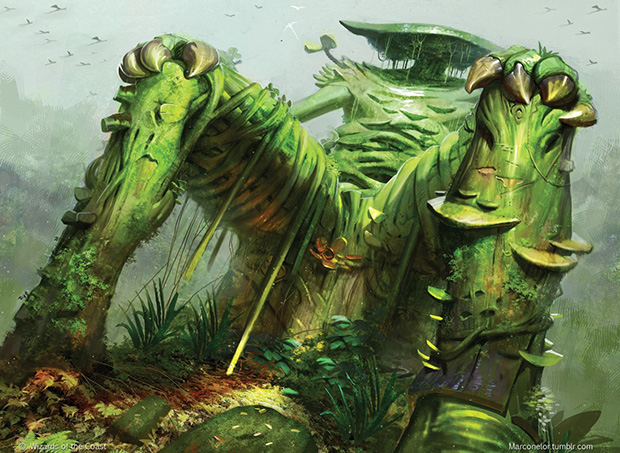
Phytotitan, by Marco Nelor. That's a fine looking chair!
MARCO NELOR: I find it almost completely impossible to paint horizontally. And that's all I've ever gotten. It's so complicated, man. Some of the things they ask you to do horizontally, it's so hard. I got the one, the jungle elemental and they're like, “We need to show, well, he's a tree. He's a fricking tree.” And it's like a horizontal thing and you're like how to show a tree....? So, of course I just defaulted to the only thing that I knew and I made this tree guy, like, sitting in this chair. [laughter] But it was, like, so so so hard to do. It's like, yeah, I just don't understand.
JEFF MIRACOLA: That's a good solution!
MARCO NELOR: Yeah, but then after six cards of people sitting in chairs... [laughter] They're like, c'mon Marco!
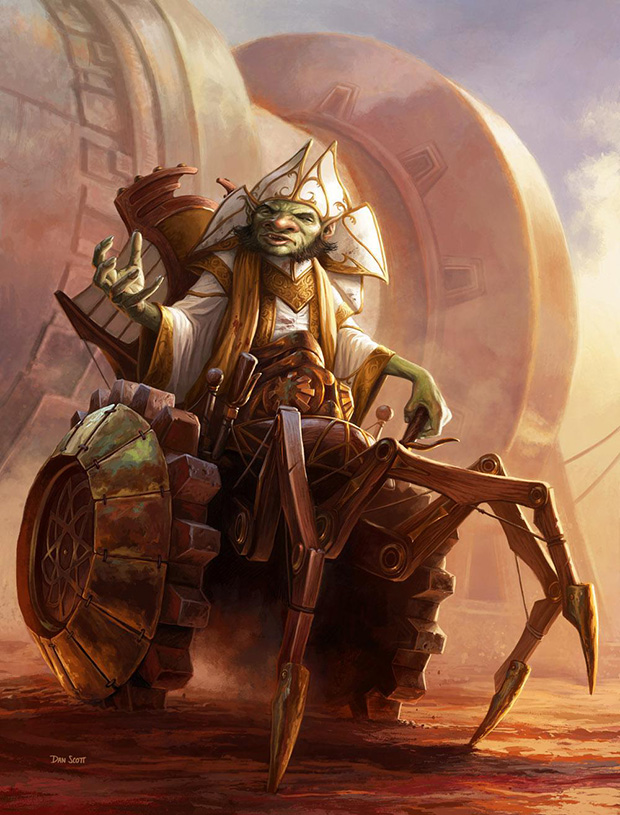
Daretti, Scrap Savant, by Dan Scott. I would pay good money for that wheelchair.
APRIL KING: Speaking of chairs, one of the pieces Dan Scott did recently, Daretti, is in this absolutely amazing wheelchair, but you can't see it at all. It almost makes me wish the card art was upside-down, so that you just see the wheelchair.
APRIL KING: Any other questions?
A3: Between lands, spells, artifacts, and creatures, what is your favorite to illustrate?
Everyone: Creatures.
JIM PAVELEC: Creatures, I could do creatures all day every day, and nothing else.
AARON MILLER: I'll take a planeswalker! [laughter]
WINONA NELSON: I love the characters.
AARON MILLER: Yeah, characters.
ANTHONY PALUMBO: I like human characters, I can't do good creatures.
MARCO NELOR: I'll let you know when I get anything more than a tree. [laughter]
JEFF MIRACOLA: Wait, his modified creature in a chair is what he likes to do.
MARCO NELOR: Yeah, creatures in chairs. [laughter]
APRIL KING: Are they the most popular with fans as well?
AARON MILLER: I think it just has to be a good card.
WINONA NELSON: Yeah, they care more about the mechanics. But for print sales, I think they like the characters better, at least in my experience.
APRIL KING: Next question.
A4: What are your favorite blocks or worlds to have made cards for?
AARON MILLER: I love them all, I just love getting that book. “Ooo, this is going to be the coolest world.”
JEFF MIRACOLA: I liked Kamigawa, because it was just so different from anything that had come before it. I liked the Asian feel to it.
WINONA NELSON: I love Innistrad. I started out on Innistrad, and I still wish I was doing more vampires.
MARCO NELOR: You kicked Innistrad's ass! [laughter] That was a really good set of yours. I remember that.
WINONA NELSON: Thanks!
DAN SCOTT: I liked Ravnica quite a bit.
MARCO NELOR: That was also good.
DAN SCOTT: I was on the conceptualizing team for the original Ravnica, so I kind of got some closeness there, but I just love the world. I love that high fantasy.
APRIL KING: Any other questions? Yes?
A5: What are you thoughts on a Magic: The Gathering artbook, or like a concept art book?
WINONA NELSON: We don't have any control over that.
JEFF MIRACOLA: We were just talking about that last night.
JIM PAVELEC: We're kind of baffled as to why they don't do art books.
MARCO NELOR: We have it, we get it every time that they make a new block.
AARON MILLER: The style guide?
MARCO NELOR: Yeah, like six guys go sit in a room on a top of a mountain and in three days they crank out a book this thick and they mail it to us and it has like everything in there and the first thing it says is, “If you ever show this book to anyone, or these books ever fall in the wrong hands...”
AARON MILLER: “You're dead!”
MARCO NELOR: I don't know why they won't release them? Maybe it's because it's kind of quick art, but it's still just sick.
WINONA NELSON: They should do a collection.
JEFF MIRACOLA: They shouldn't just include art in the book that features the art on the cards, but larger pieces, because every time somebody comes by your booth and they see a print of your art like this is they go “Oh my goodness! I'm seeing stuff in this I never saw before. There's a little squirrel there,” or something. You know what I mean? That's the kind of thing you'd love to see them do in an art book, just reprint these pieces larger for people.
MARCO NELOR: But you know, I've thought about that and I think one of the reasons why they don't do that is because I think that's part of one of the reasons why Magic art stays so fresh. Because there's not an art book to go to to say this is what I need to paint. And first of all, how do you put all the Magic pieces in there? You have to choose the best ones and then what if a person sees that and they go to paint and they're like, well it has to look like this. Because then you won't get the crazy, “Woah! Look at that!”
JIM PAVELEC: Well, I think you're looking at that from our perspective as artists. I think the fans would all probably want to buy one.
MARCO NELOR: Yeah.
JIM PAVELEC: I would want to buy one, and I don't really have much Magic work any more.
AARON MILLER: Just do one after every block, after the block is finished, and have a...
JIM PAVELEC: Well, I talked to Jeremy about that and he said that he thought that by the time the book came out and the buzz over that block was over that the sales would just drop off immediately. I asked him why not do it by color, like, the best of black cards or the best of green or you know, whatever.
DAN SCOTT: Well, you've got Spectrum, which has quite a bit of it. And they do, they used to calendars, I don't know if they still do them anymore.
AARON MILLER: But think of how many thousands and thousands and thousands of cards there are.
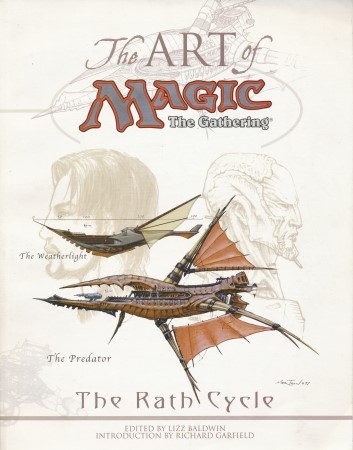
I'd happily buy one from every block ever.
JEFF MIRACOLA: They did do one art book back in the day. I mean, what was it... Invasion? [It was the Rath cycle, consisting of Weatherlight, Tempest, Stronghold, and Exodus, and was released in 1998.]
APRIL KING: Yeah, it was a long time ago. It's really surprising, because if you look at video games or movies, they're all releasing “making of this movie” books and they're always very good sellers. There's got to be somebody out there that's like, “I love Kamigawa. I cannot get enough Kamigawa!” and would totally buy the art book.
JEFF MIRACOLA: Maybe with the movie coming out...
AARON MILLER: There'll just be a book of art of the movie...
JEFF MIRACOLA: Yeah... [laughter]
APRIL KING: Last question?
A6: Magic has a lot of cards that have really weird things on in them, because of its pantheon of fictional creatures. How do you approach something where you might not be able to have a reference? Where it's not necessarily human... or a humanoid tree?
APRIL KING: How do you find a frilled oculus, and what IS a frilled oculus?
JEFF MIRACOLA: You look at the work of other artists, and you get inspired, you know? Like all those artists that we mentioned earlier. You want to get inspired, so you go look at other great artists and see what they did and see how they handled things.
JIM PAVELEC: You know, like that's my favorite thing to do with something I'm not gonna have to look at a very strict reference for. I want to make up creatures in the Magic universe and just see how far I can push it before they tell me to reign it up.
DAN SCOTT: You can't mess it up either, that's the great thing. Because there's no established reference for it, you're making it up and someone can't say, “Well, the proportions are off on that.” [laughter] “That's the way it's supposed to look.”
JIM PAVELEC: You're like, “God, I can do whatever I want.” [laughter]
WINONA NELSON: Artists can be pretty inventive with their references. We had Adam Paquette staying at our house once, and he needed to build a reference for a cube of slime. Slime cube, or something.
ANTHONY PALUMBO: It was for D&D, right?
WINONA NELSON: Yeah, for D&D. And so, we went out and got some little action figures like GI Joe dudes. Tony had this metal box that he was gonna build a synthesizer in and so we got Jell-O and we made Jell-O with the men in it. And then, flipped that over and we had slime cube. [laughter]
AARON MILLER: I would have done the same thing. [laughter]
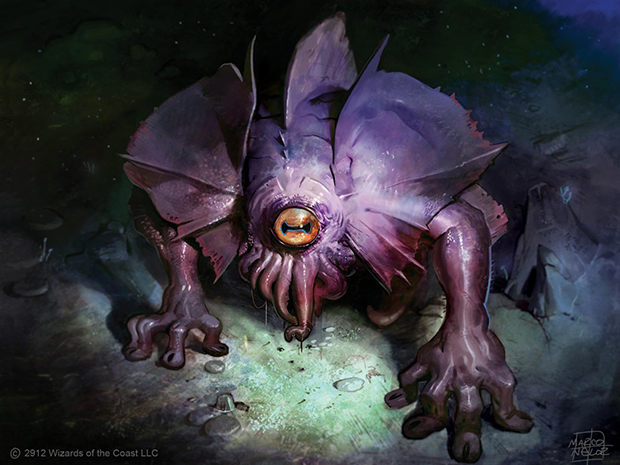
Frilled Oculus, by Marco Nelor. You can't unsee it.
MARCO NELOR: Frilled Oculus, to actually answer your question. On Jerry Springer, a long time ago, there's this guy that had no bottom half of his body and he ran around on his hands. It was his body, with a goat eye, the frills came from those Jesus Lizards [aka basilisks - Ed] that walk on the water. So, yeah, I guess like National Geographic / Jerry Springer. [laughter]
APRIL KING: Well, thank you all for coming to the panel today. I really appreciate it. You have been a fabulous audience. Please buy lots of art from them this weekend, as I'm sure they'd really appreciate it. Could we get a round of applause? [applause] Thanks a lot!




















